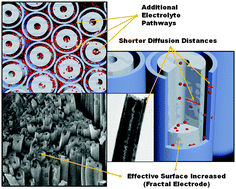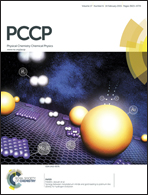A fractal-like electrode based on double-wall nanotubes of anatase exhibiting improved electrochemical behaviour in both lithium and sodium batteries†
Abstract
An anatase nanotube array has been prepared with a special morphology: two concentric walls and a very small central cavity. The method used here to achieve the double-wall structure is a single-step anodization process under a voltage ramp. Thanks to this nanostructure, which is equivalent to a fractal electrode, the electrochemical behaviour is improved, and the specific capacity is higher in both lithium and sodium cells due to pseudocapacitance. The double-wall structure of the nanotube enhances the surface of TiO2 being in contact with the electrolyte solution, thus allowing an easy penetration of the alkali ions into the electrode active material. The occurrence of sodium titanate in the electrode material after electrochemical reaction with sodium is studied by using EPR, HRTEM and NMR experiments.


 Please wait while we load your content...
Please wait while we load your content...